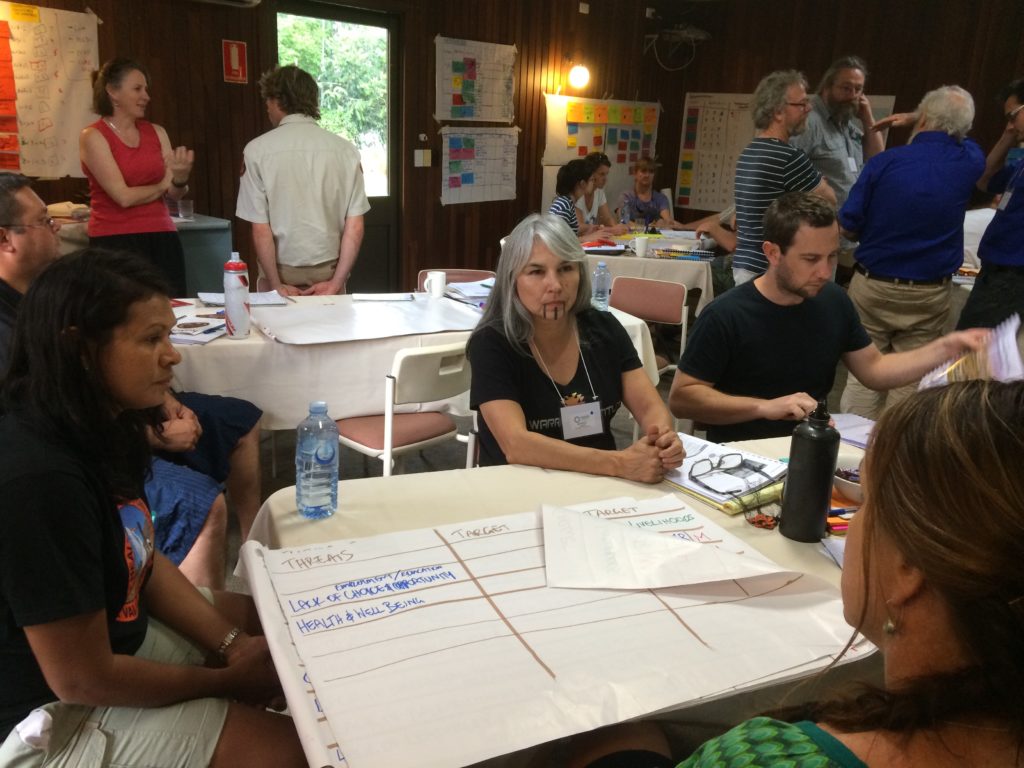Story from Mary Huffman, The Nature Conservancy and The Fire Learning Network, and Margo Robbins, Yurok Tribe
Native American people walk in two worlds: their ancestral tribal world and the contemporary world, which is led by other people. When we first started creating a network centered on fire management from indigenous peoples’ perspectives, we laid out some principles for how this would be different from other fire-related partnerships. Some principles, like self-determination, are universal to indigenous peoples around the world; others, like preparing the next generation of cultural fire practitioners, are specific to the local landscape.
In June of 2016, Blane Heumann, The Nature Conservancy’s Director of Fire Management, introduced us (the Indigenous Peoples Burning Network) to an indigenous conservation plan from Balanggarra, Australia. The plan was developed using Healthy Country Planning, a conservation planning approach adapted from the Open Standards by Aboriginal peoples in Australia. In October, Margo Robbins of the Yurok Tribe and Mary Huffman of the Fire Learning Network traveled to Darwin, Australia, for 10 days of training to learn more about the Healthy Country Planning process.
“Two things really hit us,” said Margo, “Aboriginal people there have rights to use fire that aren’t recognized here and their plans talk a lot about sustaining culture into the future.” Healthy Country Plans put the culture of Native people and their homelands as a top priority.
“In Healthy Country Planning,” Mary observed, “nobody has to ignore important spiritual relationships and nobody has to put on somebody else’s planning jacket that doesn’t fit their way of being.” To maximize local thought patterns, the plans can even be written in the local indigenous language(s), then translated for a broader readership.
After the Healthy Country Planning workshop, Margo and Mary spent time in the field with David Hinchley and Luke Preece of TNC, meeting with indigenous ranger groups and partners who showed how planning is being put into action. Margo and Mary learned that elders in the Cape York area are teaching younger generations to light cool fires before the hot, dry season or immediately before the arrival of rain storms. These cool, patchy fires remove “rubbish,” while still maintaining native species, leaving enough unburnt plants for food and cover for animals, and keeping tree canopies intact to provide much-needed shade. Mary and Margo also saw how Cape York Natural Resource Management, Ltd. is using videos and websites to help local people tell their stories of fire recovery and connect with others doing similar work across Australia.
Margo and Mary’s visit to Australia provided inspiration and guidance for the expansion of the Indigenous Peoples Burning Network and Indigenous Peoples’ Prescribed Fire Training Exchanges back in the U.S. Already, Healthy Country Planning is increasing local emphasis on and training for family-based burning. In the ancestral territories of the Yurok, Hoopa, and Karuk Tribes, controlled burning was traditionally done according to family lines. Workshop participants hope to reach their goal of building capacity for 40 families to do cool-fire controlled burns in the next three years. The Yurok-Hoopa-Karuk Healthy Country Plan will inform other land management plans with indigenous perspectives. Such plans include the fire portions of plans for adjacent federal lands, and the Community and Cultural Fire Management Plan of the Yurok Tribe.
The second Healthy Country Planning session in the Yurok-Hoopa-Karuk landscape will take place in March 2017. After the second session, the draft plan will be reviewed in a large workshop with participation from community members from all three tribes.

